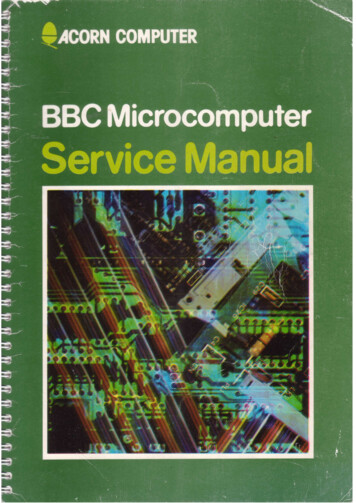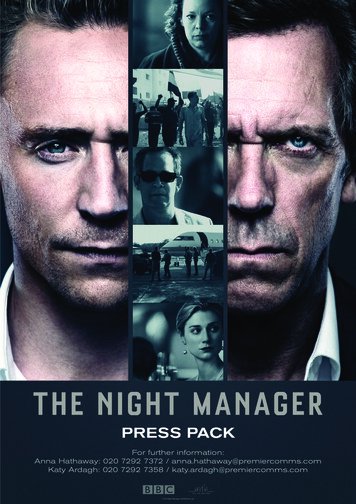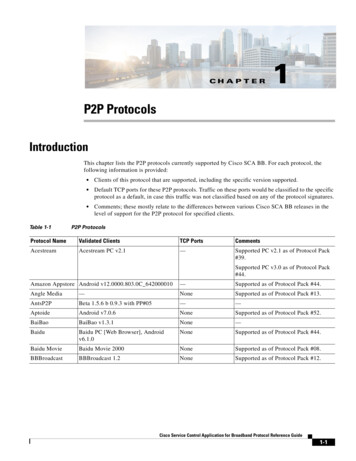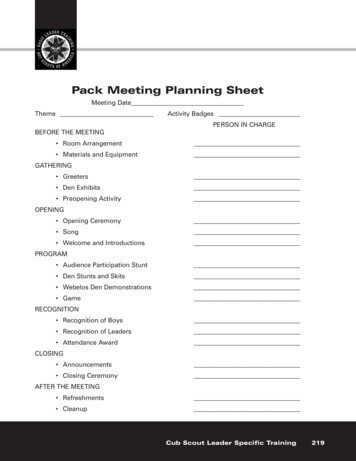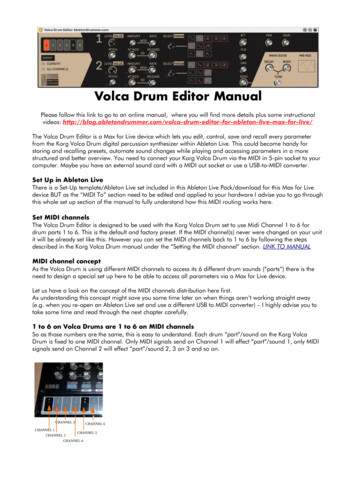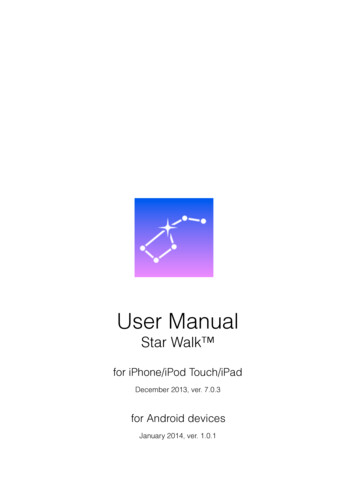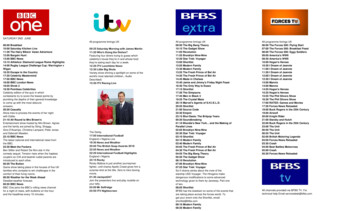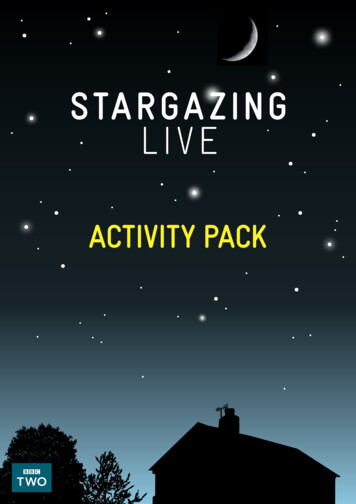
Transcription
ACTIVITY PACK
Welcome to yourStargazing LIVEActivity Pack!We have put together this activity pack to accompanythe BBC Two programme Stargazing LIVE. You can useit to help you run a Stargazing LIVE event, or to exploreastronomy further with your friends and family.The activities in this pack are suitable for a rangeof ages and abilities. Please do feel free to photocopythe activities, so you can use them with groups.You can also download further copies of the pack,accompanying curriculum links, and other freeresources at bbc.co.uk/stargazingPlease ensure that you think about safety and thesupervision of children when carrying out theseactivities and – most of all – have fun!The Stargazing LIVE Team
Mini-Planetariummini-planetariumWhat you needMake your very own mini-planetarium and use itto understand why the stars that we can see at acertain time of night change throughout the year.Umbrella Mini-Planetarium–– A black umbrella–– Small, white sticky dots–– Small, yellow sticky dots–– Long, thin stickers (any colour)–– Eight large, white stickers for labellingWhat to do:1 Open your umbrella and use the centre of theinside to represent Polaris (the North Star).PiscesCassiopeiaSagittariusGeminiPolarisUrsa MinorThe PloughVirgo2 Using the diagram as a guide, work througheach section of the umbrella and mark out theconstellations shown using the sticky dots torepresent the stars. Start with the white stickydots to create the stars in Ursa Minor, ThePlough and Cassiopeia.3 Next, use the yellow sticky dots to make theother constellations.4 Use the long, thin stickers to mark connectinglines between the stars in each constellation.5 Write the name of each constellation ontoa large sticker. Stick each name next to itsmatching constellation.6 Once you have completed your miniplanetarium, you can use it to spot theseconstellations in the night sky. Note that notall the constallations in the sky are shown onyour umbrella and not all will be visible in asingle night, so make sure you look carefully.7 You can also watch the relevant ‘How to’ videoat bbc.co.uk/stargazing to find out why thestars we see at a certain time of night changethroughout the year.Mini-planetarium activity produced withthanks to Dan Hillier of Dark Sky Scotland.
Solar EclipseviewerWhat is a solar eclipse?What you needA solar eclipse occurs when the Earth, the Moonand the Sun are all aligned with one another insuch a way that from Earth, the Moon appears toblock the light coming from the Sun.One of the safest and easiest ways to view asolar eclipse is with a pinhole viewer. Here’show to make one.Solar Eclipse VIEWER–– An empty cereal box–– Scissors–– Glue–– Aluminium foil (approx. 10cm by 10cm)–– Sticky tape–– A strip of white paper – the same size asthe bottom of your cereal box–– A pin–– A ruler CEREALBOXholewithlioFEclipse CerealCompanyWhat to do:herek inLooSafetyChildren will need adult supervision.Remember! Looking directly at the Sun canpermanently damage your eyes. You must neverlook at the sun directly or use any devices suchas binoculars or telescopes to view it.bbc.co.uk/stargazing1 Open your cereal box at the top and stick thewhite paper onto the inside of the bottom ofthe box using glue. This is going to be the‘viewing area’.2 Cut off the two small tabs at the top of thebox and cut off 4cm from each end of the twolarger flaps.3 Fold the remaining flaps together and securewith sticky tape so that you have a box withtwo rectangular holes in the top.4 Place the foil over the hole on the right-handside of the box and secure with sticky tape.5 Carefully pierce the middle of this foil with thepin – making sure that you only make a verysmall hole.Your pinhole viewer is now ready to use! Lookinto the box through the uncovered hole, whilstmaking sure the foil-covered hole is pointingtowards the Sun. Move the box until an imageof the Sun appears on the ‘viewing area’ at thebottom of the box.
Photograph theNight Skyis it DIFFICULT?Photographing the night sky isn’t as hard as youmight think. Most cameras are capable ofcapturing basic shots of the stars, but what youcan achieve depends on how much control yourcamera gives you over its settings.What you need–– A digital camera–– A tripod (optional)–– Shutter release cable (optional)What to do:1 Position the CameraTripods are a great way of holding the camerasteady whilst you point it at the sky. If youdon’t have one, rest your camera on a solidand sturdy base instead.2 Set the FocusMake sure you turn the auto-focus functionoff because it doesn’t work well with the lowlight conditions of the night sky. Then set yourcamera’s focus to infinity.3 Refine the FocusTo get the best results, point your camera at abright star and adjust the focus until the objectis as sharp as you can get it.4 Adjust the ApertureSet the camera’s f-number to the smallestnumber possible. This means the lens aperture(hole) will be at its largest and will therefore letmore light into your camera.5 Adjust the ZoomIf your camera has a zoom capability, use thelowest zoom setting to give you the widestangle shot.6 Adjust the SensitivityCamera sensitivity is adjusted via the ISOsetting. The higher the ISO, the easier it isto see faint objects, but it also increases thedigital ‘noise’ in your pictures. If you thinksome of the stars in your image may be dueto noise, turn down the ISO setting. If you’renot sure, cover the lens with card and take apicture – any ‘stars’ that appear in this imageare due to digital noise.Now all you need to do is to point your cameraat some bright stars and get clicking!Top Tip!You can use a shutter release cable or a shutterdelay timer to help prevent camera shake causedwhen you press the shutter button.Why not try Experimenting with exposure times as the longerthe exposure you use, the more stars you’re likelyto record. If you leave the shutter open for at leasta minute, you might start to get images of startrails as the stars appear to move across the nightsky. Basic cameras may not be able to take suchlong exposures, however DSLRs can if you setthem onto their ‘bulb’ exposure setting and usea shutter release cable to hold the shutter open.
Make an OrreryWhat is an Orrery?An Orrery is a mechanical model of the SolarSystem. Here you can make a simple Orrery,showing the Sun, Earth and Moon, and howthey move.SafetyChildren will need adult supervision.What you need–– Scissors–– 2 paper fastenersDID YOU KNOW?A day is the length of time it takes for theEarth to completely spin on its axis, whichis approximately 24 hours.A lunar month is the time it takes for the Moonto complete one set of phases (full Moon backto full Moon) and is approximately 29.5 days.A year is the time it takes for the Earth tocomplete one orbit of the Sun, which isapproximately 3651/4 days.What to do:1 Carefully cut out the four templates shownon the next page.3 Place the Earth over Piece 1, and secure allthree pieces together with a paper fastener.Completed OrreryeTh oonM2 x paper fastenersOne5 Your Orrery is now ready to use. You can orbitthe Moon around the Earth and see how itseems to change over a month. You could alsotry orbiting the Earth around the Sun to seehow it moves throughout a erMaybbc.co.uk/stargazingNigDecemberAprilOrrery activity produced with thanks to the Wynyard Woodland ParkPlanetarium and Observatory.ydamonthOne4 Now place Piece 2 on top of the Sun whereshown and secure with another paper fastener.Earth2 Place Piece 1 where shown on top of Piece 2.SeptemberJuneAugustJuly
The OrreryOnethonmNightPlace Piece1 hereOnethonmNightTheMoonDayOne dayPlace Piece1 herePlace EarthhereOnOne yearThe EarthMoonethonmNightDayOne dayPlace Piece1 herePlace EarthhereOne yearEarthTheMoonPieceDay1One dayPlace EarthhereOne erPiece 2FebruaryAprilJanuaryDecemberPlace PieceMay2 hereNovemberOctoberJuneAprilMayPlace Piece2 hereThe SunSeptemberAugustOctoberJulySeptember FebruaryAprilMarchOctoberPlacePieceNovember2 here MarchDecember
Rocket JUICESpace rockets use either solid or liquid fuel topropel them from Earth. Here you can build yourown rocket that’s powered by air!SafetyChildren will need adult supervision.What you need–– A small empty drinks carton with bendy straw–– Sticky tack–– Sticky tape–– Scissors–– GlueWhat to do:1 Carefully cut out the four templates on thenext page. The rectangle will make the bodyof your rocket, and the other three templateswill make the fins.2 Lay the rectangle flat on the table, pictureside down, and put the long part of the strawover the top of it. Roll the paper around thestraw, making sure that it’s a snug fit (butnot too tight!).3 Secure the rolled paper with sticky tapeand then remove it from the straw.4 Fold over one end of the rolled paper at thedotted line and secure in place with sticky tape.5 Now take the fins and fold along thedotted lines.6 Apply glue to all of the printed sides of eachfin. Stick the middle rectangles to the yellowzone of the rocket and stick the triangles ofthe fins together as shown.bbc.co.uk/stargazingYour rocket is now ready, so it’s timeto make the launcher!1 To do this, insert the short end of the strawinto the carton and seal any gaps betweenthe straw and carton with sticky tack (it’simportant that your launcher is airtight).2 Place your rocket onto the straw and you’reready. To launch the rocket simply squeezethe carton and watch your rocket fly!3 Now, why not decorate your carton?DID YOU KNOW?By squeezing the carton you push the air frominside it into the body of the rocket. This air isthen pushed out the bottom of the rocket,launching it forwards and into the sky!
Rocket JUICESections to cut out"3"32"StargazeSpace Rocket2"StargazeSpace Rocket11Note: Glue thefins with thesame numberstogether.Final rocket oncarton ready to launch!
‘CAn’stellationSConstellations are arrangements of stars thatare shown to represent objects, animals ormythological creatures. There are 88 officialconstellations, and different ones can be seen inthe night sky throughout the year. But if you can’tget outside, or it’s too cloudy to see the realconstellations, why not make a constellation ofyour own – in a can! These can be seen anywhereat anytime. Just follow these instructions.SafetyChildren will need adult supervision.What you need–– Empty crisp can (the ones that are 8cmin diameter work best)–– Scissors–– Sticky tack–– Drawing pin–– Nail–– Hammer–– Torch (optional)bbc.co.uk/stargazingWhat to do:1 Use the nail and hammer to carefully makea small hole in the centre of the metal endof the can. This will be your viewing hole.2 Carefully cut out one of the constellationtemplates on the next page.3 Place your chosen template on top of a ballof sticky tack and use the drawing pin tocarefully make a small hole at the centre ofeach of the stars. (The sticky tack will stopthe pin from pricking your fingers or the table!)4 Remove the template from the sticky tack andplace it inside the plastic lid of the crisp can.If it helps, you can use a bit of sticky tack toensure it’s held in place.5 Put the lid on the can and point it towardsthe light. Look through the viewing hole atthe bottom and you should see your veryown constellation.6 Now, why not try putting a torch inside thecrisp can and pointing it upwards? If you turnout the lights, you should be able to see thestars on your ceiling!
‘CAn’stellationsUrsa MajorOrionPerseusLeo
bbc.co.uk/stargazingDesign: red-stone.com Published by BBC Learning 2011MC4 A4 Media Centre201 Wood LaneLondon W12 7TQ
STArgAzIng lIVe ACTIVITY PACK! We have put together this activity pack to accompany the BBC Two programme Stargazing LIVE. You can use it to help you run a Stargazing LIVE event, or to explore astronomy further with your friends and family. The activities in this pack are suitable for a rang
